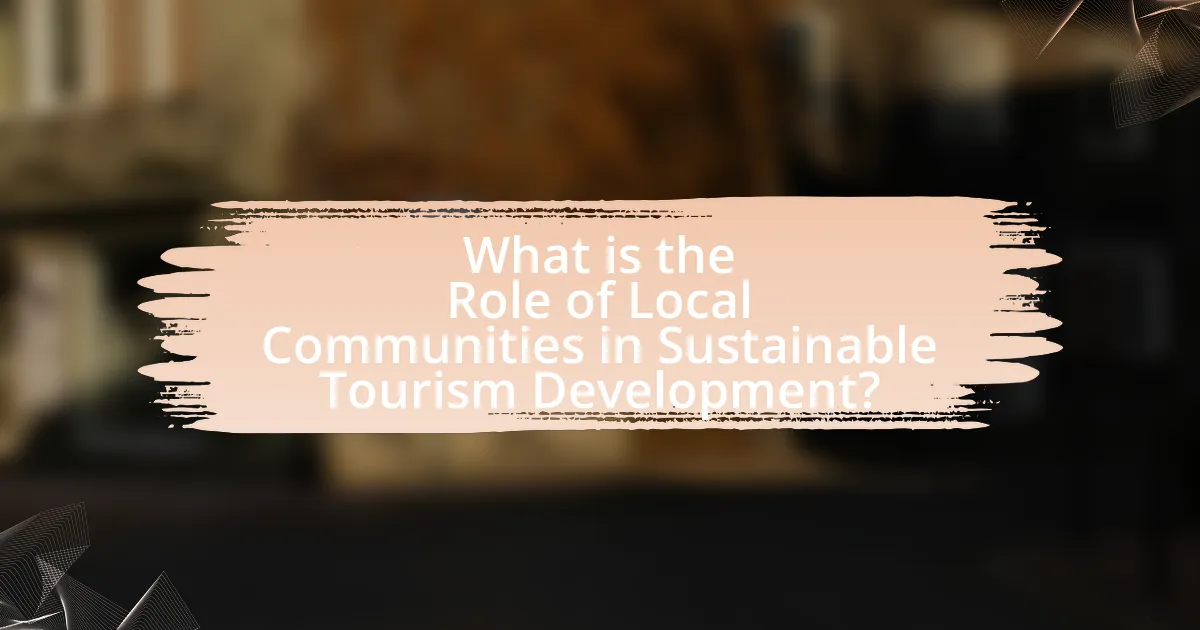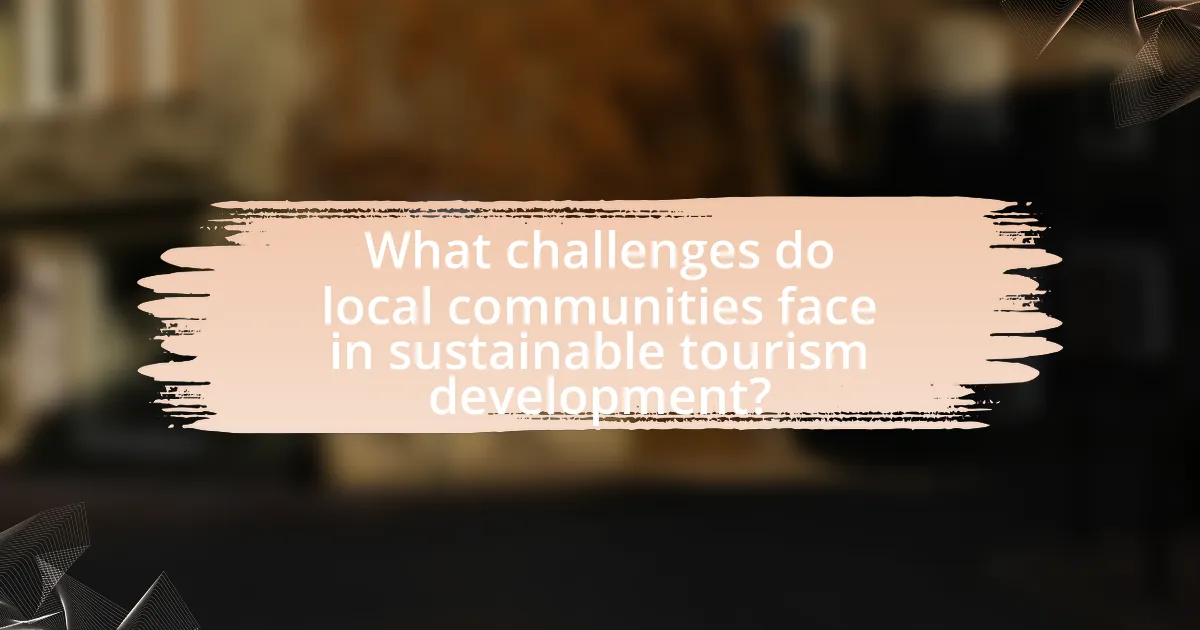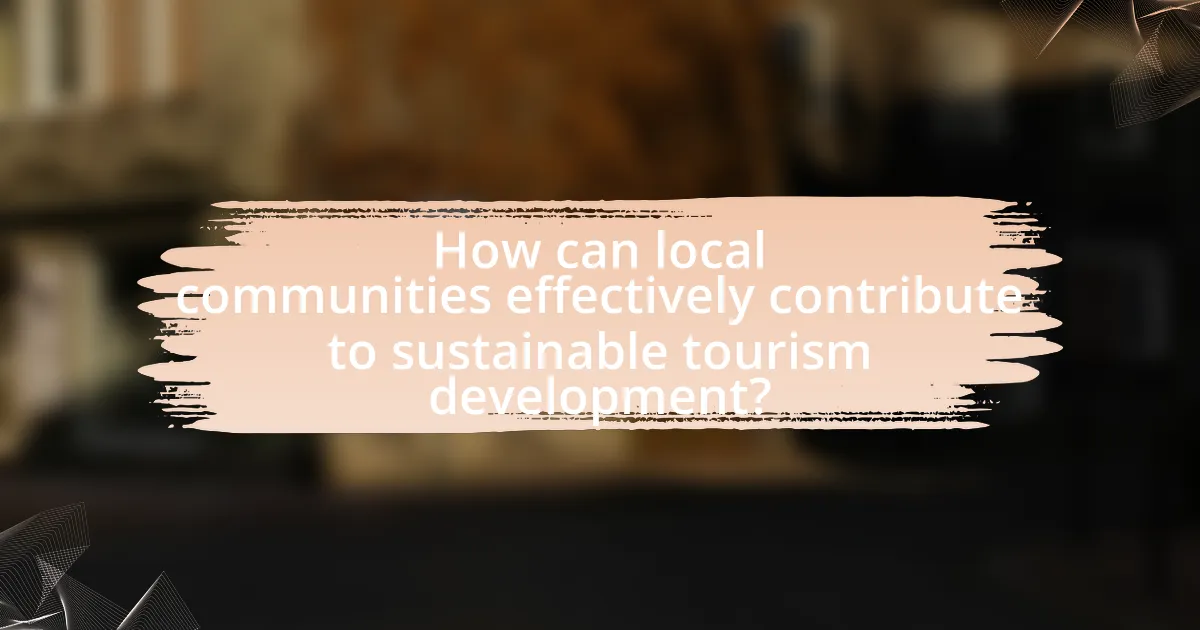Local communities are integral to sustainable tourism development, as their active participation in decision-making processes ensures that tourism practices reflect their cultural, social, and environmental values. The article explores how community involvement enhances tourism sustainability by promoting local culture, advocating for eco-friendly practices, and generating economic benefits. It highlights key factors enabling community engagement, such as effective communication and local empowerment, while also addressing challenges like economic dependency and cultural erosion. Additionally, the article discusses strategies for preserving local traditions and the importance of partnerships in fostering sustainable tourism outcomes.

What is the Role of Local Communities in Sustainable Tourism Development?
Local communities play a crucial role in sustainable tourism development by actively participating in decision-making processes and ensuring that tourism practices align with their cultural, social, and environmental values. Their involvement helps to preserve local traditions and ecosystems while promoting economic benefits that directly support community well-being. For instance, studies show that when local residents are engaged in tourism planning, there is a 30% increase in community satisfaction and a 25% increase in the economic benefits retained within the community. This highlights the importance of local input in creating tourism strategies that are both sustainable and beneficial to the community.
How do local communities influence sustainable tourism practices?
Local communities significantly influence sustainable tourism practices by actively participating in decision-making processes and promoting local culture and resources. Their involvement ensures that tourism development aligns with community values and environmental conservation efforts. For instance, communities often advocate for eco-friendly practices, such as waste management and conservation of natural habitats, which are essential for maintaining the integrity of local ecosystems. Research indicates that when local residents are engaged in tourism planning, there is a higher likelihood of implementing sustainable practices that benefit both the environment and the economy, as seen in case studies from destinations like Costa Rica, where community-led initiatives have led to increased biodiversity and economic resilience.
What are the key factors that enable community involvement in tourism?
Key factors that enable community involvement in tourism include effective communication, local empowerment, and economic benefits. Effective communication fosters collaboration between stakeholders, ensuring that community voices are heard and integrated into tourism planning. Local empowerment allows communities to take ownership of tourism initiatives, leading to more sustainable practices that reflect local culture and values. Economic benefits, such as job creation and revenue sharing, incentivize community participation by demonstrating tangible advantages. Research by the United Nations World Tourism Organization highlights that communities engaged in tourism development experience increased social cohesion and improved quality of life, validating the importance of these factors.
How does community engagement enhance the sustainability of tourism?
Community engagement enhances the sustainability of tourism by fostering local ownership and stewardship of resources. When communities actively participate in tourism planning and decision-making, they are more likely to prioritize environmental conservation and cultural preservation. For instance, a study by the United Nations World Tourism Organization found that destinations with strong community involvement in tourism management experience less environmental degradation and greater economic benefits for local residents. This collaborative approach ensures that tourism development aligns with the community’s values and needs, leading to long-term sustainability.
Why is local community participation essential for sustainable tourism?
Local community participation is essential for sustainable tourism because it ensures that tourism development aligns with the needs and values of the local population. Engaging local communities fosters a sense of ownership and responsibility towards natural and cultural resources, which leads to more effective conservation efforts. Studies show that when communities are involved in tourism planning and decision-making, they are more likely to support sustainable practices, as evidenced by the success of community-based tourism initiatives in places like Costa Rica, where local involvement has led to increased biodiversity conservation and economic benefits for residents.
What benefits do local communities gain from sustainable tourism development?
Local communities gain economic, social, and environmental benefits from sustainable tourism development. Economically, sustainable tourism creates jobs and stimulates local businesses, leading to increased income for residents. For instance, a study by the World Tourism Organization found that every job in tourism generates 1.5 additional jobs in related sectors. Socially, sustainable tourism fosters community pride and cultural exchange, enhancing social cohesion and preserving local traditions. Environmentally, it promotes conservation efforts, as communities engage in protecting their natural resources to attract tourists, which is evidenced by initiatives like the ecotourism projects in Costa Rica that have led to significant biodiversity preservation.
How does local participation affect the environmental impact of tourism?
Local participation significantly reduces the environmental impact of tourism by fostering sustainable practices and conservation efforts. When local communities are actively involved in tourism development, they are more likely to implement measures that protect natural resources, such as managing waste, conserving biodiversity, and promoting eco-friendly activities. For instance, a study by the United Nations Environment Programme found that destinations with strong local community engagement saw a 30% reduction in waste generation compared to those without such involvement. This demonstrates that local participation not only enhances environmental stewardship but also leads to more sustainable tourism outcomes.

What challenges do local communities face in sustainable tourism development?
Local communities face several challenges in sustainable tourism development, including economic dependency, environmental degradation, and cultural erosion. Economic dependency arises when communities rely heavily on tourism for income, making them vulnerable to fluctuations in tourist numbers. Environmental degradation occurs as increased visitor traffic can lead to habitat destruction and pollution, undermining the natural resources that attract tourists. Cultural erosion happens when local traditions and practices are overshadowed by commercial tourism, leading to a loss of cultural identity. These challenges highlight the need for balanced approaches that prioritize community involvement and sustainable practices in tourism planning.
How do economic factors impact community involvement in tourism?
Economic factors significantly influence community involvement in tourism by determining the financial benefits and opportunities available to local residents. When communities perceive tourism as a viable source of income, they are more likely to engage in tourism-related activities, such as providing services, participating in decision-making, and promoting local culture. For instance, a study by the World Bank indicates that communities with higher income levels from tourism are more likely to invest in sustainable practices and infrastructure, enhancing their overall participation. Additionally, economic stability encourages local businesses to collaborate with tourism operators, fostering a symbiotic relationship that benefits both parties.
What are the financial barriers to local community participation?
Financial barriers to local community participation include limited access to funding, high costs associated with participation, and lack of financial literacy. Limited access to funding restricts community members from engaging in initiatives that require investment, such as tourism projects. High costs can deter participation in events or programs that require fees, travel, or materials. Additionally, a lack of financial literacy can prevent community members from effectively navigating funding opportunities or managing resources, further hindering their involvement in sustainable tourism development.
How can communities overcome economic challenges in tourism development?
Communities can overcome economic challenges in tourism development by fostering collaboration among local stakeholders, enhancing skills through training programs, and diversifying tourism offerings. Collaborative efforts, such as partnerships between local businesses, government, and non-profits, can lead to shared resources and knowledge, which are essential for addressing economic barriers. For instance, a study by the World Tourism Organization highlights that regions with strong stakeholder collaboration experience 20% higher economic growth in tourism compared to those without. Additionally, providing training programs equips residents with necessary skills, improving service quality and attracting more visitors. Diversifying tourism offerings, such as promoting eco-tourism or cultural experiences, can also mitigate risks associated with economic downturns in specific sectors, as evidenced by research from the Journal of Sustainable Tourism, which indicates that communities with varied tourism products are more resilient to economic fluctuations.
What social and cultural challenges affect local communities in tourism?
Local communities in tourism face several social and cultural challenges, including cultural commodification, loss of identity, and social inequality. Cultural commodification occurs when local traditions and practices are altered or commercialized to meet tourist expectations, leading to a dilution of authentic cultural expressions. For instance, in Bali, traditional ceremonies have been modified to cater to tourists, impacting the community’s cultural integrity. Additionally, the influx of tourists can lead to a loss of local identity as communities adapt to external demands, often prioritizing tourist satisfaction over their own cultural values. Social inequality is exacerbated as tourism can create economic disparities, where benefits are unevenly distributed, often favoring large corporations over local businesses. According to a study by the United Nations World Tourism Organization, communities that do not engage in tourism planning may experience increased tensions and conflicts, highlighting the need for inclusive approaches to mitigate these challenges.
How does tourism impact local traditions and cultural heritage?
Tourism significantly impacts local traditions and cultural heritage by both promoting and commodifying them. The influx of tourists often leads to the revitalization of cultural practices, as communities showcase their traditions to attract visitors, which can enhance cultural pride and preservation. For instance, festivals and traditional crafts may receive renewed attention and funding due to tourism, as seen in places like Bali, where local ceremonies are celebrated and adapted for tourist engagement. However, this commercialization can also dilute authentic cultural expressions, as communities may alter traditions to meet tourist expectations, risking the loss of original meanings and practices. Research indicates that while tourism can provide economic benefits and cultural exchange, it can also lead to cultural homogenization, where unique local identities are overshadowed by global trends.
What strategies can communities use to preserve their culture while engaging in tourism?
Communities can preserve their culture while engaging in tourism by implementing strategies such as cultural education programs, community-led tourism initiatives, and the promotion of local artisans. Cultural education programs inform tourists about local traditions, customs, and history, fostering respect and understanding. For instance, the Maori in New Zealand have successfully integrated cultural education into their tourism offerings, enhancing visitor experiences while preserving their heritage. Community-led tourism initiatives empower local residents to manage tourism activities, ensuring that profits benefit the community and that cultural practices are maintained. An example is the community-based tourism in Thailand, where local villages offer authentic experiences that reflect their culture. Additionally, promoting local artisans helps sustain traditional crafts and practices, as seen in the markets of Oaxaca, Mexico, where local craftspeople showcase their work to tourists, preserving their cultural identity. These strategies collectively support cultural preservation while allowing communities to engage meaningfully with tourism.

How can local communities effectively contribute to sustainable tourism development?
Local communities can effectively contribute to sustainable tourism development by actively engaging in decision-making processes and promoting local culture and resources. When communities participate in tourism planning, they ensure that development aligns with their values and needs, which can lead to more sustainable practices. For instance, a study by the United Nations World Tourism Organization highlights that community involvement in tourism can enhance environmental conservation efforts and improve economic benefits for local residents. By prioritizing local businesses and cultural experiences, communities can create a unique tourism offering that attracts visitors while preserving their heritage and environment.
What best practices can local communities adopt for sustainable tourism?
Local communities can adopt several best practices for sustainable tourism, including promoting local culture, supporting local businesses, and implementing environmental conservation measures. By prioritizing local culture, communities can create authentic experiences that attract tourists while preserving their heritage. Supporting local businesses ensures that economic benefits remain within the community, fostering resilience and sustainability. Implementing environmental conservation measures, such as waste management and habitat protection, helps maintain the natural resources that attract tourists. These practices are validated by studies showing that communities engaging in sustainable tourism see increased visitor satisfaction and economic stability, as highlighted in the “Sustainable Tourism Development: A Global Perspective” report by the United Nations World Tourism Organization.
How can communities leverage local resources for tourism development?
Communities can leverage local resources for tourism development by utilizing their unique cultural heritage, natural landscapes, and local products to create authentic experiences for visitors. For instance, communities can promote local festivals, traditional crafts, and culinary specialties, which not only attract tourists but also enhance local pride and economic benefits. According to a study by the World Tourism Organization, destinations that emphasize local culture and resources see a 20% increase in tourist satisfaction and repeat visits. This approach fosters sustainable tourism by ensuring that economic gains are reinvested into the community, preserving local traditions and environments.
What role does education play in empowering communities for sustainable tourism?
Education plays a crucial role in empowering communities for sustainable tourism by equipping individuals with the knowledge and skills necessary to manage resources responsibly and promote local culture. Through education, community members learn about sustainable practices, environmental conservation, and the economic benefits of tourism, which fosters a sense of ownership and responsibility towards their local environment. For instance, programs that educate locals on biodiversity and cultural heritage can lead to more informed decision-making regarding tourism development, ensuring that it aligns with community values and ecological sustainability. Studies have shown that communities with higher levels of education in tourism management are more successful in implementing sustainable tourism initiatives, as they can effectively engage with stakeholders and adapt to changing market demands.
How can partnerships enhance the role of local communities in tourism?
Partnerships can enhance the role of local communities in tourism by fostering collaboration between local stakeholders, government entities, and private sector organizations. This collaboration enables communities to actively participate in decision-making processes, ensuring that tourism development aligns with their cultural values and economic needs. For instance, the World Tourism Organization emphasizes that community involvement in tourism planning leads to more sustainable practices and better resource management, as local insights contribute to the preservation of cultural heritage and natural resources. Additionally, partnerships can provide local communities with access to training and funding, empowering them to develop tourism-related businesses that create jobs and stimulate local economies.
What types of partnerships are most beneficial for local communities?
Collaborative partnerships between local communities and stakeholders such as government agencies, non-profit organizations, and private sector businesses are most beneficial for local communities. These partnerships facilitate resource sharing, enhance local capacity, and promote sustainable practices that align with community needs. For instance, a study by the United Nations World Tourism Organization highlights that community-based tourism initiatives, which involve local residents in decision-making processes, lead to increased economic benefits and cultural preservation. Additionally, partnerships with non-profits can provide training and support for sustainable tourism practices, further empowering local communities and ensuring long-term viability.
How can collaboration with stakeholders improve sustainable tourism outcomes?
Collaboration with stakeholders can significantly enhance sustainable tourism outcomes by fostering shared goals and resources among local communities, government entities, and private sector partners. This cooperative approach allows for the integration of diverse perspectives, leading to more effective planning and management of tourism activities that prioritize environmental conservation and cultural preservation. For instance, a study by the United Nations World Tourism Organization (UNWTO) highlights that destinations with strong stakeholder engagement report higher visitor satisfaction and lower environmental impact, demonstrating that collaborative efforts can lead to more sustainable practices and policies.
What practical steps can local communities take to promote sustainable tourism?
Local communities can promote sustainable tourism by implementing eco-friendly practices, engaging in community-based tourism initiatives, and educating visitors about local culture and environmental conservation. Eco-friendly practices include using renewable energy sources, reducing waste, and promoting local food production, which can decrease the carbon footprint associated with tourism. Community-based tourism initiatives empower locals to manage tourism activities, ensuring that economic benefits remain within the community and that cultural heritage is preserved. Education programs for visitors can enhance awareness of local ecosystems and traditions, fostering respect and responsible behavior. These steps not only enhance the visitor experience but also contribute to the long-term sustainability of the community and its resources.